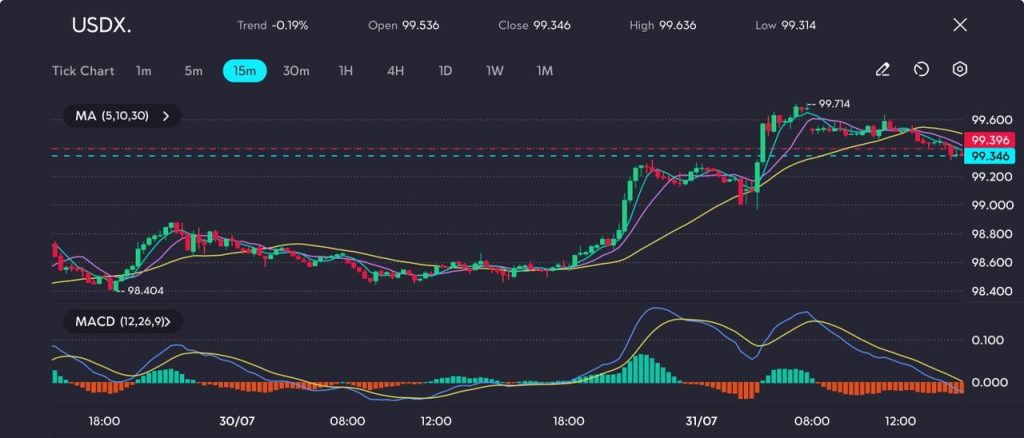
The US dollar saw a change in direction this week as focus shifted from interest rate expectations to growing global risks. Strong economic data supported early gains, but renewed trade tensions and geopolitical uncertainty prompted a more cautious market outlook.
Dollar slips as risk sentiment overtakes policy focus
The US dollar saw a modest retreat on Thursday, following a midweek rally that had driven the Dollar Index (USDX) to a two-month peak of 99.983.
By the end of the session, the index had slipped 0.2%, closing at 99.606 as market attention shifted from monetary policy cues to escalating global risk factors.
The greenback’s earlier gains were fuelled by stronger-than-anticipated US economic indicators, including upbeat private payroll figures and a GDP reading that exceeded forecasts.
This positive data underpinned the dollar during the week, with additional support coming from Federal Reserve Chair Jerome Powell’s measured tone at the latest policy meeting.
While interest rates remained unchanged, Powell refrained from signalling any clear direction for potential rate cuts, leaving investors uncertain about the outlook for September.
Thursday’s trading sentiment was largely shaped by comments from President Trump, who confirmed there would be no further extension to Friday’s trade deadline. He also announced new 50% tariffs targeting Brazil and copper-related imports.
Additionally, Trump criticised Canada’s recognition of a Palestinian state, suggesting it could complicate ongoing trade discussions – introducing fresh uncertainty for North American economic relations.
Technical analysis
After rebounding from the 98.40 support area on 30 July, the USDX embarked on a steady upward trajectory, establishing a bullish pattern marked by a series of higher lows.
In the early hours of 31 July, the index broke decisively above 99.20, sparking a rapid move that topped out at 99.714.
However, the rally lost steam just above that resistance level, prompting a minor retracement toward the 99.35 zone.

Picture: USDX rally stalls below 99.75 as momentum eases, as seen on the VT Markets app.
Following the peak, short-term moving averages (5, 10, and 30) began to converge and slope downward, with both the 5- and 10-period MAs crossing below the 30-period – an early indication of potential trend reversal. Currently, the price is consolidating near this moving average cluster, attempting to establish fresh support.
The MACD histogram highlights a clear decline in bullish momentum. Green bars are tapering off, while the MACD line approaches a bearish crossover beneath the signal line. Should this crossover confirm, it may reinforce the likelihood of near-term downside movement.
At present, 99.20 represents the first key level of support, with 98.90 serving as a secondary target should selling pressure increase.
Conversely, a decisive close above 99.60 would negate the pullback scenario and open the door for a potential retest of 99.71 or even a push toward the psychological barrier at 100.00.
Cautious forecast
A sustained break below 99.30 would likely bring the 99.00 region into focus as the next key area of support, potentially opening the door for a deeper correction if bearish momentum accelerates.
Below this level, further downside could see price action test 98.90 or even revisit the 98.40 zone that previously acted as a strong base.
Conversely, a decisive rebound above 99.60 would suggest that bullish sentiment remains intact, possibly paving the way for a retest of 99.71 and a push toward the psychologically significant 100.00 mark.
A break above this threshold could attract renewed buying interest and signal a continuation of the broader uptrend.
Ultimately, the near-term direction of the US dollar hinges on the outcome of Friday’s trade negotiations, which may reshape market sentiment significantly.
Any unexpected policy announcements or geopolitical tensions – particularly from the White House – could inject volatility into currency markets and influence dollar flows in the sessions ahead.
Click here to open account and start trading.





